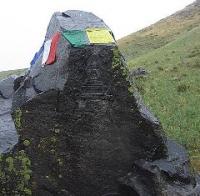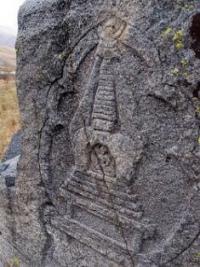Вы здесь
Buddhist drawings of the Semirechye.


Rock paintings of Kazakhstan.
"Cutting off the bonds of ignorance with a flaming sword on a lotus"
Tours on rock Buddhist drawings in Kazakhstan.
Buddhism as a world religion was formed in India in the VIth century BC. During the reign of Emperor Ashoka (268 - 231 BC), pilgrims and preachers from India are sent throughout Asia to spread the new religion.
Buddhism is actively penetrating the countries of Central Asia, starting from the first centuries of a new era. With the fall of the Mauryev and Shung Empire under the Kushans in North India, the decline of Buddhist influence begins, Buddhist monks rush to the North to Iran and Central Asia. In the Ist - IIIrd centuries A.D. Buddhist monasteries arise in Sogd.
Until the VIIth century A.D. Buddhism penetrates the territory of nomads and the settled population of South Kazakhstan precisely from Iran and Sogd. But in this early period, mainly Buddhism professed a sedentary population of cities.
Another center for the spread of Buddhism among nomads is Xinjiang. Starting in the IVth century, translations of Buddhist texts from Sanskrit and Tibetan have already been carried out in East Turkestan. In the VIth century, the first Buddhist texts appear recorded in the ancient Turkic runic script.
In the VI century, the Uyghur tribes that entered the Great Turkic Kaganate adopted Buddhism and contributed to its spread in the northeastern part of the Seven Rivers, and at the beginning of the 8th century, Buddhism generally became the state religion of the Uyghur Kaganate.
The Karluk tribes that broke away from this state in 766 migrated to Semirechye, also contributed to the spread of Buddhism in a nomadic environment. The third wave of the spread of Buddhism in Kazakhstan also comes from Mongolia and Tibet.
On the territory of Mongolia, the interest of the nomadic nobility of the Great Turkic Haganate in Buddhism manifests itself in the VI century. From the "Bugutsk inscription" it is known that Taspar-Kagan is already making an attempt to introduce Buddhism as a state religion.
Kagan invited preachers from India, built a temple and established a Buddhist community. At the court of Kagan, Sogdian Buddhists also lived. The text of the “Bugutsk inscription” itself was carved on one side of the stele - in Sanskrit in Brahmi letters, and on the other in Sogdian.
It is in these two languages that virtually all religious Buddhist texts were distributed in the northern part of Central Asia. But pagan beliefs still prevailed among Turkic tribes for a long time. In the early period, only an insignificant part of the higher nobility from the environment of Kagan himself accepted Buddhism, and this acceptance was rather formal.
In the VIIth century, Buddhism spreads in Tibet, but at the end of the IXth century, Khan Landarma, who himself professed the ancient Bon religion, forbids Buddhism and begins mass persecution of monks and preachers throughout Tibet.
The bulk of Tibetan Buddhists flees to Mongolia and Semirechye. From the end of the IXth - beginning of the Xth centuries, the active spread of Buddhism among nomads begins. A new wave of the spread of Buddhism in Kazakhstan begins in the XIIIth century in connection with the creation of the Genghis Khan Empire.
The Mongols, having captured Tibet, actively supported the Buddhist clergy, which contributed to their missionary activity throughout the Empire. After the death of Genghis Khan, the Mongols themselves embrace Buddhism as a state religion and, until the middle of the XVIIIth century, they promote the spread of this religion in Kazakhstan.
It is with the spread of Buddhism from Mongolia and Tibet that the Buddhist complexes of the Ili River valley are associated. Currently, in the territory of the Semirechye in Kazakhstan and Kyrgyzstan, a large number of Buddhist inscriptions in the Tibetan language are known.
The bulk of these inscriptions are associated by researchers with the period of the Dzungarian expansion (XVII - XVIII centuries). Inscriptions close in iconography are known in Issyk-Kul, in the vicinity of the village of Tamga, in the mountains of the Dzungarian Alatau.
If we choose analogies close in iconography and style to the images of the Tamgaly-Tas tract on the Ili River, not far from the Kapshagai Hydroelectric Power Station, then, first of all, it is necessary to consider the central figure of the whole composition - Chon Rai Chik and Burkhan with snakes, since the images of Buddha and Man La do not have such bright specific features in style and iconography. Buddhist images that are close in iconography and style can be found in archaeological materials of East Kazakhstan and Mongolia.
For example, in the Ablai Palace, images of many-armed Burkhanes were found, similar to the image of Chon Rai Chik from Tamgaly-Tas, they date back to the XVII - XVIII centuries. Similar style images can be found in Tibet and Mongolia.
Very similar in style and iconography is the image of Manjushri or Burkhan, "cutting off the bonds of ignorance with a flaming sword on a lotus." Manjushri was portrayed in Mongolia sitting in a lotus position, a lotus flower is shown in his left hand, symbolizing purity of thoughts, salvation from samsara, and the very teachings of Buddhism.
The hairstyle of the Mongolian burkhan is shown by the same expressive means: the robe and double halo coincide, covering the whole scene. A complete analogy to the drawings of the Tamgalytas Sakya Muni tract is a bronze Mongolian figurine from the Hermitage collection, which reliably dates from the XVIIth century.
The popularity of the many-armed Burkhan, "cutting off the bonds of ignorance with a flaming sword" in the XVIIth century Dzungaria is not accidental. In 1635, Erdeni Batur Huntayji became the ruler of the Dzungar Khanate.
He received this title from the Dalai Lama Gendong - Zhamtso. The title "huntaiji" itself means "ruling according to the laws of the Buddha." Erdeni Batur begins an active conquest policy, and Burkhan, "cutting off the bonds of ignorance," becomes one of the main characters revered by the ruler and all jungars.
It is likely that the Buddhist composition of Tamgaly-Tas was created precisely during the reign of Erdeni Batur Khuntaji, presumably during the signing of the truce (1646 - 1650) between the Kazakh Khan Zhangir and the Dzungarian Erdeni Batur.
Under this agreement, hostilities ceased and trade between Kazakhstan and the Dzungarian Khanate resumed. It is interesting that after the death of Erdeni Batur Khuntayji in 1655, the popularity of this burkhan decreases, and by the beginning of the XVIII century it is already depicted much less often.
Authority:
The book "Rock paintings of the Seven Rivers", authors: Maryashev AN, Goryachv A.A. second edition revised and updated, Almaty, 2002.







